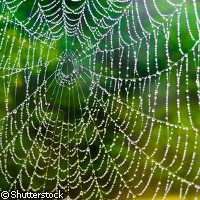Apr 25 2009
German scientists have added tiny amounts of metal to spider silk to make it even stronger and more elastic. The technique could lead to the development of super-tough textiles, surgical thread or artificial tissues such as bones or tendons, the researchers say. Tough, lightweight materials could also be useful for applications in fields as diverse as construction, aircraft technology and space technology.

Spider silk is famously tougher and lighter than steel. In this latest study, published in the journal Science, the researchers borrowed a trick from nature with the goal of further enhancing the properties of this already remarkable material.
Many insects and other creatures incorporate small amounts of metals such as zinc, manganese, calcium or copper into body parts like jaws, claws and stingers to make them stiffer and harder. The scientists drew on a technique called 'atomic layer deposition' (ALD) to get zinc, titanium and aluminium ions into the spider silk.
Normally ALD just leaves a layer of metal oxides on the surface of the treated fibre; treating spider silk in this way therefore had little impact on its strength. However, by adapting the technique slightly, the researchers were able to get the metal ions to infiltrate the spider silk and become part of the thread.
Silk treated in this way is both stronger and more elastic than untreated silk; according to the scientists, these properties mean it takes 10 times more energy to break a treated thread than it does to break a natural, untreated thread.
'Our work promises great potential in terms of practical applications, as many other biomaterials can be made more break-resistant and ductile using our method,' explained Dr Mato Knez of the Max Planck Institute of Microstructure Physics in Germany.
However, there is a catch: the technique only works on materials that are made largely out of proteins. Even so, Dr Knez and his team have already used this to their advantage - they succeeded in using the technique to strengthen threads made of collagen, the protein that protects our bones from breaking and our skin from tearing.
The exact mechanism by which the metal infiltrates the silk and makes it stronger remains unknown. However, the scientists are not without ideas. 'We assume that the metal atoms bind the protein molecules to each other,' Dr Knez speculates.
Usually, hydrogen atoms form the links between the different molecules that make up spider silk. These hydrogen bonds probably weaken or break during the ALD process, allowing the metal atoms, which create stronger bonds, to take their place.
Dr Knez emphasises that metal-enhanced spider silk is unlikely to be used in industrial applications in the near future; spiders are not easy to keep and the amount of silk they produce is relatively small. Nevertheless, he is optimistic that the new technique will lead to the development of new materials.
He concludes: 'We are pretty certain that we will also be able to improve the properties of synthetic materials that imitate natural ones using our process.'
Source: Cordis